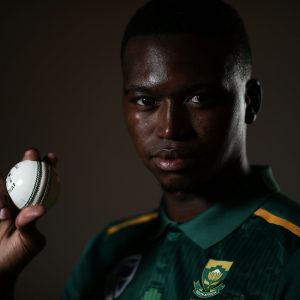The roots of racism run deep in SA cricket
Cricket’s foundation phase is littered with racism, from the structural in elite all-boys schools that produced 65% of the Proteas who have played at a World Cup to the overt where black talent is …
Author:
29 July 2020

On 27 October 2019, Soweto Pioneers Cricket Club abandoned its match against Khosa Cricket Club at the Stan Friedman Oval in Krugersdorp, west of Johannesburg. Pioneers captain Linda Ndlovu and coach Marumo Morena were found guilty of breaching the Central Gauteng Lions Cricket Board’s (CGLCB) code of conduct and handed a four-match ban each. The league points were awarded to Khosa as the non-defaulting team.
These are the facts as presented in the CGLCB five-member disciplinary panel’s report, which New Frame has seen. In 100 years’ time, if anyone cares to look, this impartial recording of history will convey a simple narrative.
But here is a different account of that same event.
A group of black men from South Africa’s largest township travelled to the majority white, Afrikaans town on their northwestern border for a game of cricket. The Pioneers only came into existence in 2016, after the merger of Soweto Cricket Club and Dobsonville Cricket Club, two proud institutions that could no longer stand on their own. Khosa has thrived since its inception in 1917, the same year Ernest Oppenheimer founded multinational mining company Anglo American.
None of this mattered as Pioneers opener Levert Manje skimmed across the surface of history in his knock of 109 that helped set a score of 269/7. It was a defendable target and memories of inequality and oppression were stowed away as thoughts turned to the procurement of 10 wickets.
After 10 overs of Khosa’s reply, a white police officer in full uniform walked on to the field and brought play to a halt. A phone belonging to a Khosa player had gone missing and fingers were being pointed at the 18-year-old in Soweto colours. Insults were exchanged. The atmosphere grew hostile.
According to Morena’s testimony, the Pioneers were “mentally not in the correct frame of mind” to continue the match as they felt “intimidated by the presence of a police officer in Krugersdorp”. The CGLCB found that there was no just cause for the game to end as they said no player was “intimidated or victimised”.
The term “victim mentality” is all too familiar in the discourse around racial equality in South Africa. It is an insidious phrase that delegitimises pain and denies individuals their place in the sweeping narrative of the country. What the disciplinary panel saw as an innocuous intervention by a police officer was an extremely painful reminder of a shared trauma for those involved.
Ngidi’s comments and the skeletons it let out
This has been a watershed month for South African cricket. It began with Proteas fastbowler Lungisani Ngidi vocalising his support for the global Black Lives Matter (BLM) movement. That evoked a knee-jerk reaction from a small group of retired white players who cried that “all lives matter” and dismissed the desire for an egalitarian society as “Marxist” ideology.
In turn, 36 black players, coaches and administrators signed an open letter throwing their weight behind Ngidi and BLM. Several active players, including Tabraiz Shamsi, Rassie van der Dussen and former captain Faf du Plessis, have also stood with Ngidi.
Related article:
On 18 July, Nelson Mandela’s birthday, everyone inside SuperSport Park took a knee and raised their fist ahead of Cricket South Africa’s (CSA) three-team fundraising event, the Solidarity Cup. This is merely the start, though, and it remains to be seen if these overdue conversations and heartening gestures lead to meaningful change. Either way, it is significant that those in the upper echelons of the sport have adjusted their sails to the changing winds.
But what is the lay of the land further down the pyramid? Is everything green down at the grassroots?
“I still see racism and racial biases happening in youth cricket, and I’m not positive that things will change any time soon,” says Ntsongo Sibiya, the chairperson of Gauteng-based key interest group Black African Cricket Clubs.
“I regularly get reports from coaches and parents that at area trials and provincial weeks, young black children don’t get the opportunity to prove their talent. That selectors assume excellence upon white kids, but black kids have to prove them wrong. The sad thing is this biased mindset comes from both black and white coaches.”
This is partly owing to the cognitive hangover from apartheid. But it is also a matter of resources and cricket’s reliance on access to wealth. It is no coincidence that since readmission, 65% of the 119 players who have represented South Africa at a men’s World Cup attended an elite school for boys.
While these schools are slowly transforming to more accurately reflect the demographics of the country, they largely remain bastions of white identity with deep roots in a colonial heritage encapsulated by the Victorian ethos of muscular Christianity. Children outside of these privileged hubs have little chance of becoming a Protea.
Related article:
“It is crucial we harness our cricket diversity and to do this, we need to provide opportunities for talented players living in townships,” says Gary Kirsten, the former Proteas opening batter and coach whose foundation provides assistance with training and investment in facilities in disadvantaged areas.
“This can only be achieved by building the necessary infrastructure and then setting up programmes at schools. It is essential that township schools can compete and beat traditional elite schools. I believe that with adequate facilities and coaching this is completely feasible,” he says.
What the CSA is doing to address the imbalance
The CSA is in agreement and has poured almost R135 million into rural and township cricket in the past three years. This war chest has helped fund travel and equipment, programme operational costs, coaches’ salaries, and often school fees and feeding schemes.
For CSA youth and tertiary cricket manager Niels Momberg, organic transformation is akin to an oil tanker. “It takes a long time to turn,” he says. “We know we have a huge problem with facilities and we’ve tried to rectify that.
“But we can’t put a high-class turf pitch in Alexandra and expect the next Temba Bavuma to emerge in five years. These guys will always be competing against schools that have, in some cases, a century’s worth of ingrained excellence and high standards. It’s a psychological battle as much as it is one of resources.”
Related article:
It may be several generations before a school in Langa can consistently mix it with the top all-boys schools in Cape Town. This is why the CSA has recently turned its attention to what Momberg terms “focus schools”. These are former model C schools outside of the elite bubble but with an existing framework that could yield fruit if adequately nurtured.
Momberg identifies Queens High School in east Johannesburg as a prime example of this medium-term approach. Its student body is 98% black African. It has four grass wickets with manicured outfields, multiple nets and a functioning clubhouse.
“Queens girls cricket dominates their competition in Johannesburg and we’re already seeing a few boys graduate to the Lions academy,” says Momberg.
Investing in a school like Queens makes sense on a number of fronts. It offers a more immediate return on the CSA’s investment compared with schools in townships. This could accelerate organic transformation, which would satisfy politicians and fans who remain frustrated by the largely white national teams. It also offers an alternative avenue to the top for a young black child without having to traverse the unfamiliar landscape of an elite all-boys school.
“It can be really tough for children when they are plucked from their home community and placed in an environment which is totally unfamiliar and out of context,” Kirsten says of the psychological challenges involved when a gifted youngster like Ngidi or Bavuma is given the chance to flourish among affluence.
“Everything is new and many battle with language barriers and integration into a new culture and social environment. Added to this, there is often a demand on their performance, academically and on the sports field, and even more pressure to set the example of what is possible for the communities they come from.”
There are numerous accounts from black cricketers, particularly batters, describing the extra pressure they feel by virtue of their skin colour. “I realise that every time I step out there I am carrying the hopes of many people,” Bavuma told British newspaper The Telegraph in December.
The burden of being a black Protea
This added burden at any level is a hindrance to performance. When that is compounded by prejudice – real or perceived – the chances of registering a hundred or claiming a five-wicket haul is greatly diminished.
“I always had to work harder than my white teammates,” says Ahmed Omar, the former Gauteng wicketkeeper. He also donned the gloves for the South African Under-19 tour of England in 1995, in a team that included Mark Boucher, Ashwell Prince, Makhaya Ntini with Neil McKenzie as the skipper. “I was constantly fighting against the system.”
Omar’s curiosity got the better of him one day and he opened an envelope containing the payslip of a white provincial teammate. He couldn’t believe what he saw. Omar was earning a monthly wage of R800 a month while his contemporary was taking home R3 000.
“I don’t begrudge any white player who has done well,” Omar says. “Boucher, for example, took his chances as a keeper and became a legend. But he got the chance. I was always one knock away from getting a chance and when you consider how little I was being paid, that tells you everything you need to know about the system. The sad thing is, I never spoke about this at the time because I was afraid of being labelled a troublemaker. A lot of us suffered in silence.”
Related article:
Some vocal critics on social media, such as former national selector Hussein Manack, have called for an equivalent of the Truth and Reconciliation Commission in South African sport. Sibiya adds that such a committed act of introspection and interrogation would have to include accounts from the lower levels of the game.
Great strides have been made in recent years as a consequence of intervention by the government and the CSA, as well as the natural transformation of the middle class and elite schools. Many critics may bemoan selection targets, but there is little doubt that these have given players opportunities they would otherwise not have received.
It is worth noting that since the CSA implemented a policy of “targets within targets” – whereby each age-group representative side has had to include two black Africans in their top six since the start of the 2017-2018 season – the number of runs scored and balls faced by black Africans per match has increased dramatically in every province. Significantly, this has not been to the detriment of other races.
But this fails to address the need for a nationwide psychological recalibration. The CGLCB may boast of a transformed board and 85% black coaching staff throughout the organisation, but it still failed to acknowledge the trauma experienced by the Soweto Pioneers players.
“Moving forward, black lives must also matter to black people,” Sibiya says in response to the point that most of the people with power in South African cricket are not white. “Maybe it’s a generational thing. The great triumph of apartheid was making both black and white people believe in white supremacy.”
How to fix this problem
This story has yet to run its course. The anecdotes shared for this piece alone could fill a novel on the subject. No one interviewed denied that there is a problem of racism woven into the fabric of South African cricket at all levels.
“It is impossible for me as an ex-Protea player and coach to be a contributor to a better solution for black cricketers in this country without acknowledging my own naivety and poor awareness,” concludes Kirsten in a rare moment of integrity and honesty from a white athlete in his 50s.
“Very few can deny the subconscious bias that may have been fuelling the fire of racial divide in South African cricket over the past years. Personally, I apologise for the hurt I have caused others. I am acutely aware that for me to make a contribution to a new and transformed cricket environment in our country will require many hours of listening to the numerous stories of pain and hurt prevalent for many black players.”
While we’re listening, let us not forget to turn our ear to those still gazing up at their future in this sport. Cricket’s survival in South Africa depends on it.




